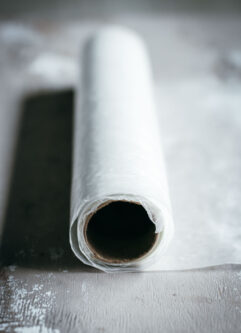Is Wax Paper Environmentally Friendly?
Wondering if wax paper is environmentally friendly? We dive into how wax paper is made, how to dispose of it, and how to replace single-use wax paper with reusable alternatives.
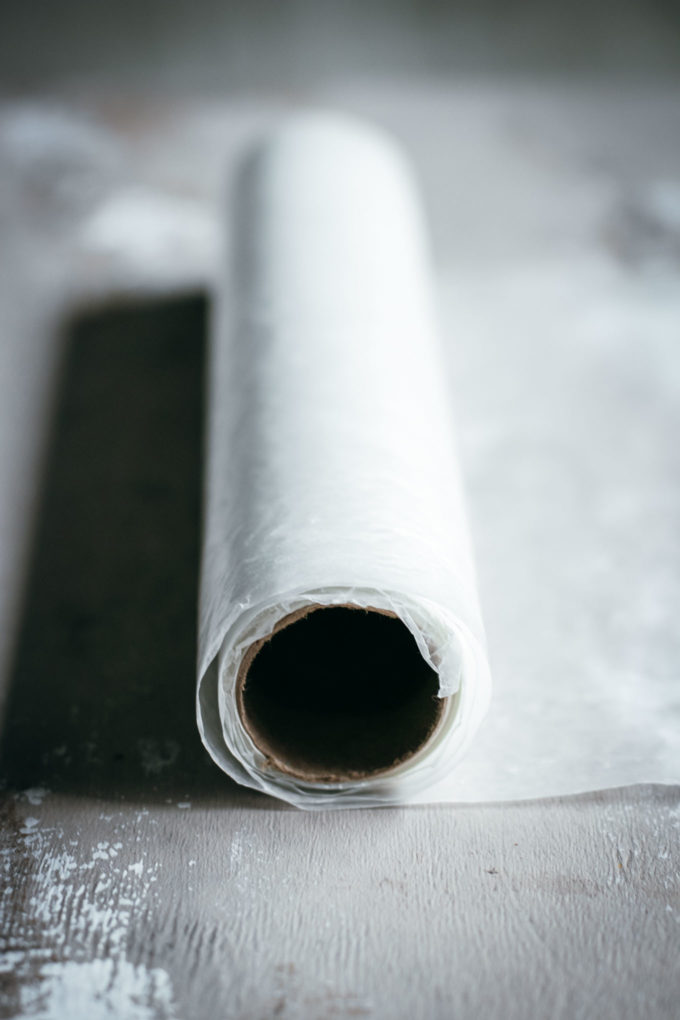
Want to Save This Recipe?
Enter your email & I’ll send it to your inbox. Plus, get new plant-based recipes in your inbox!
By submitting this form, you consent to receive emails from Fork in the Road.
Wax paper is an environmentally friendly alternative to other food storage options, like plastic wrap or aluminum foil. Most types of wax paper are biodegradable, and some can be composted. While wax paper is not inherently bad for the environment, the amount you throw out can add up and accumulate in landfills.
To make your wax paper use eco-friendly, first you should know about the types of wax paper, how it’s made, and some wax paper alternatives.
Ready to learn about whether wax paper is eco-friendly? Let’s do it!
❓ What is wax paper?
Wax paper is a common kitchen paper product that is used for wrapping and storing food. It contains a wax coating, which makes it moisture-proof, and it’s a great plastic wrap alternative.
The non-stick and water-resistant properties of wax paper are what make it a staple household kitchen tool. It can be cleaned easily and reused several times for storage or lining countertops when rolling out baked goods, like pie crusts and bread.
Wax paper is similar to parchment paper and it is used in similar ways in the kitchen, however it should not be used for hot applications like baking (unlike parchment paper, which is fine for hot uses).
Wax paper is considered non-toxic, as it is free of toxic additives like plasticizers, UV stabilizers, and fire retardants. It’s also BHA, PVC, and BPA-free, which is a plus for both humans and the environment.
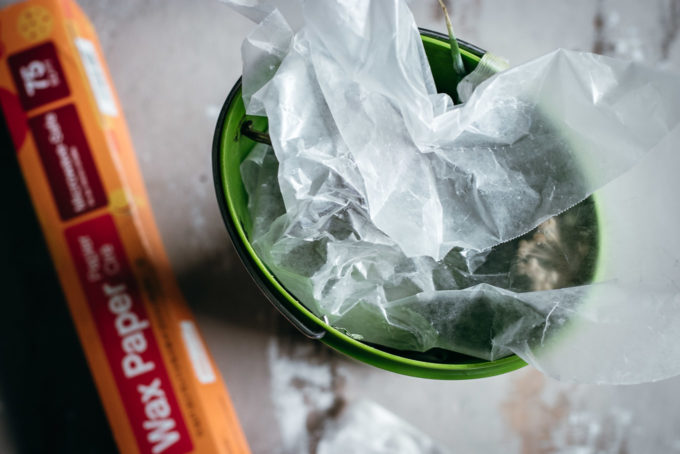
📜 How Wax Paper is Made
Wax paper is made following the same steps as regular paper, with the addition of wax to make it moisture-resistant. The wax is forced into the fibers of the paper and used to coat the outside layers.
Thinner paper typically works better for waxing, and the method used depends on how thick the paper is. Here is an overview of the three grades of coating:
- Wet-waxed: The wax coating is applied to both sides of the paper, often by submerging the paper in a wax bath. The wax layer is continuous in this application.
- Dry-waxed: The sheet of paper is coated using heated rollers and the wax is applied in layers.
- Wax-laminated: The barrier is increased by incorporating two substrates into the wax paper, like foil or another kind of paper.
All grades of wax paper are biodegradable, although beeswax and soybean wax paper are more environmentally friendly and better for composting.
📃 Types of Wax Paper
There are a few different types of wax paper, and some are more eco-friendly than others. The differences between them are the types of waxes that are used, which are described below:
- Paraffin wax: Can be made from coal, petroleum, shale, or vegetable oil — the most common type of wax paper that you’ll find at the store.
- Soybean wax: Vegan and sustainably sourced. Good option for businesses that use a lot of wax paper, but need to remain cost-effective.
- Beeswax: Generally eco-friendly option, designed with reusability in mind, but is not vegan because it is a product made by animals. Tends to be more expensive than other wax paper options, but lasts the longest.
You will also find bleached and unbleached versions of wax paper. The chemicals used during the bleaching process could have detrimental effects on the environment, and thus we suggest using unbleached wax paper when necessary.
It can be difficult to find unbleached wax paper, so beeswax paper is your best bet if you’re looking for something that is environmentally friendly without chemical additives.
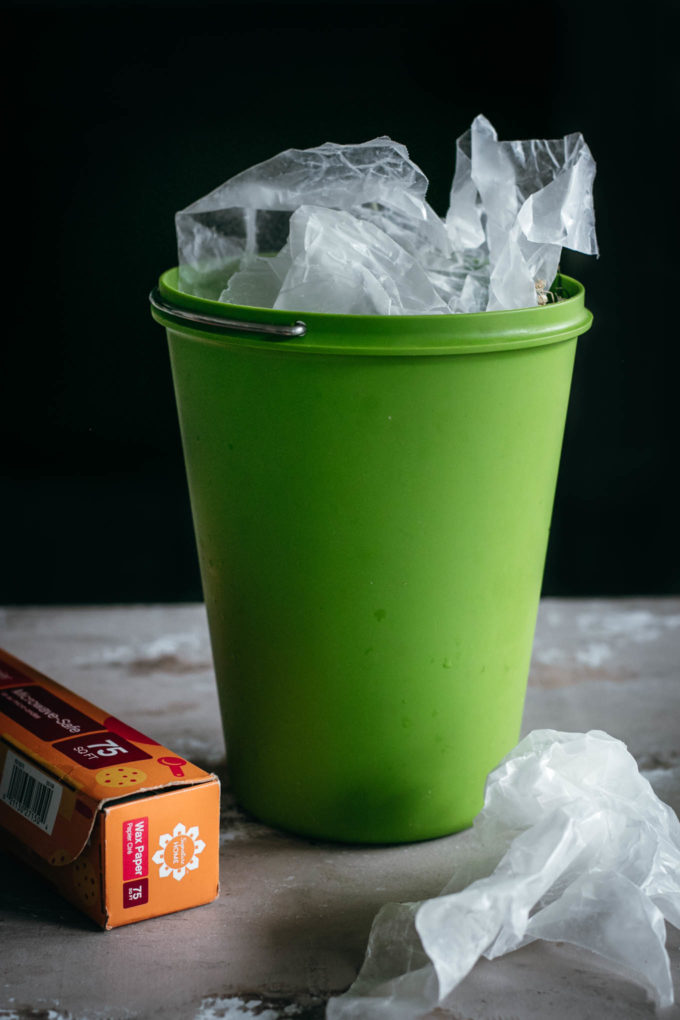
🗑 How to dispose of wax paper
When you need to dispose of wax paper, you should first think about whether you are able to reuse it. Some ways of throwing out wax paper are more sustainable than others, so it’s important to consider how to make the most eco-friendly choice.
♻️ Composting wax paper
Wax paper’s compostability depends on the type of wax that it’s coated with. The chemicals in petroleum wax are not safe for composting, while wax paper coated with vegetable oil, soybean oil, or beeswax can be composted.
It takes about 2-4 weeks for wax paper to break down in compost. For the best results, make sure the carbon to nitrogen ratio is maintained in your compost pile with a variety of green and brown materials.
👉 RELATED: See our full guide How to Compost Wax Paper to figure out if your wax paper can be thrown in the compost bin.
🔄 Reusing wax paper
You can get multiple uses out of wax paper as long as you are able to clean it. This is a great way to decrease the amount you end up throwing out. Clean the paper after each use, and use it for cold storage purposes. Wrapping sandwiches and saving baked goods in the freezer are common ways to use it.
⬇️ Reduce the amount of wax paper that you use
To cut back on waste from wax paper, simply try to reduce the amount that you use. Glass containers and mason jars are great wax paper alternatives.
🚮 Throw wax paper in the trash
As a last resort, you can throw used wax paper in the trash. It will end up in a landfill, but it is biodegradable and will eventually break down. This is not the most sustainable option when you think about how much wax paper is used as a whole.
♻️ Is wax paper recyclable?
Unfortunately, wax paper can not be recycled due to its water-resistant coating. Instead of recycling, we recommend reusing or composting — or not using wax paper at all and opting for reusable food storage instead of single-use options.
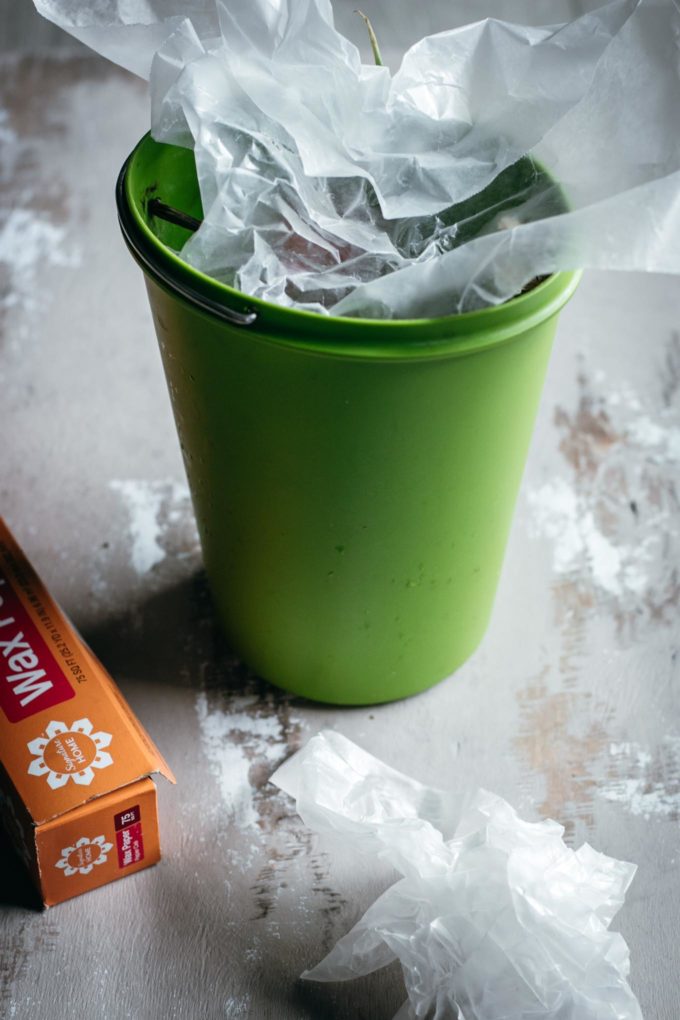
💚 More eco-friendly kitchen tips
Want more tips for going green in the kitchen? We’ve got you covered with these sustainable kitchen guides:
- Zero Waste Kitchen Start Guide
- Are Paper Bags Compostable?
- Can You Put Single-Use Tea Bags in Compost?
- Can You Compost Wax Paper?
- Can You Throw Paper Towels in the Compost Bin?
- Are Silicone Baking Mats Sustainable?
- Is Parchment Paper Eco-Friendly?
♻️ Want more inspiration for going green in the kitchen? Join the Green Living Community for plant-based recipes, sustainable kitchen hacks, and get our FREE guide to meal planning to reduce food waste!

